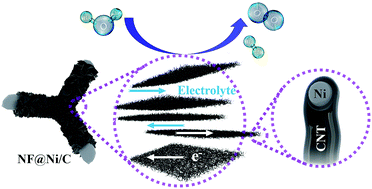当前位置:
X-MOL 学术
›
Energy Environ. Sci.
›
论文详情
Our official English website, www.x-mol.net, welcomes your
feedback! (Note: you will need to create a separate account there.)
A hierarchical nickel–carbon structure templated by metal–organic frameworks for efficient overall water splitting†
Energy & Environmental Science ( IF 32.4 ) Pub Date : 2018-06-21 00:00:00 , DOI: 10.1039/c8ee00934a Hao Sun 1, 2, 3, 4, 5 , Yuebin Lian 1, 2, 3, 4, 5 , Cheng Yang 1, 2, 3, 4, 5 , Likun Xiong 1, 2, 3, 4, 5 , Pengwei Qi 1, 2, 3, 4, 5 , Qiaoqiao Mu 1, 2, 3, 4, 5 , Xiaohui Zhao 1, 2, 3, 4, 5 , Jun Guo 4, 6, 7, 8 , Zhao Deng 1, 2, 3, 4, 5 , Yang Peng 1, 2, 3, 4, 5
Energy & Environmental Science ( IF 32.4 ) Pub Date : 2018-06-21 00:00:00 , DOI: 10.1039/c8ee00934a Hao Sun 1, 2, 3, 4, 5 , Yuebin Lian 1, 2, 3, 4, 5 , Cheng Yang 1, 2, 3, 4, 5 , Likun Xiong 1, 2, 3, 4, 5 , Pengwei Qi 1, 2, 3, 4, 5 , Qiaoqiao Mu 1, 2, 3, 4, 5 , Xiaohui Zhao 1, 2, 3, 4, 5 , Jun Guo 4, 6, 7, 8 , Zhao Deng 1, 2, 3, 4, 5 , Yang Peng 1, 2, 3, 4, 5
Affiliation

|
The development of high-performance and cost-effective catalysts for the hydrogen and oxygen evolution reactions is key to efficient electrocatalysis of water, which offers a promising solution to convert and store those green but unsteady energies. Herein, we report a hierarchical nickel–carbon composite, fabricated by directly growing sheet-like Ni–MOFs on commercial nickel foam prior to high-temperature annealing, as a highly efficient bifunctional catalyst. This composite shows remarkable catalytic activities for both the hydrogen and oxygen evolution reactions in an alkaline electrolyte, affording a current density of 10 mA cm−2 at an overpotential of 37 mV for the HER and 265 mV for the OER. Furthermore, an electrolyzer employing the composite as a bifunctional catalyst in both the cathode and the anode delivers a current density of 35.9 mA cm−2 at a cell voltage of 1.60 V with extended stability, which is even superior to the integrated Pt/C and RuO2 counterparts. This excellent performance is believed to be a result of a concerted synergy due to its hierarchical structure, enabling excellent reaction kinetics. Further ex situ XRD and XPS analyses reveal that while metallic nickel is responsible for the HER, Ni nanoparticles with an oxide shell encapsulated in graphitic carbon are the OER catalytically-active sites formed in situ.
中文翻译:

由金属-有机框架模板化的分层镍-碳结构,可实现有效的总水分解†
开发用于氢气和氧气逸出反应的高性能且具有成本效益的催化剂是水高效电催化的关键,这为转化和存储这些绿色但不稳定的能量提供了有希望的解决方案。本文中,我们报告了一种分层的镍-碳复合材料,它是在高温退火之前直接在商用镍泡沫上生长片状Ni-MOF制成的,是一种高效的双功能催化剂。该复合材料对碱性电解液中的氢气和氧气放出反应均显示出显着的催化活性,电流密度为10 mA cm -2HER的过电势为37 mV,OER的电势为265 mV。此外,在阴极和阳极中均采用复合物作为双功能催化剂的电解槽在1.60 V的电池电压下具有35.9 mA cm -2的电流密度,并具有扩展的稳定性,甚至优于集成的Pt / C和RuO 2个同行。这种出色的性能被认为是由于其分层结构而协同协同作用的结果,能够实现出色的反应动力学。进一步的非原位XRD和XPS分析表明,虽然金属镍是引起HER的原因,但具有包裹在石墨碳中的氧化物壳的Ni纳米颗粒是原位形成的OER催化活性位点。
更新日期:2018-06-21
中文翻译:

由金属-有机框架模板化的分层镍-碳结构,可实现有效的总水分解†
开发用于氢气和氧气逸出反应的高性能且具有成本效益的催化剂是水高效电催化的关键,这为转化和存储这些绿色但不稳定的能量提供了有希望的解决方案。本文中,我们报告了一种分层的镍-碳复合材料,它是在高温退火之前直接在商用镍泡沫上生长片状Ni-MOF制成的,是一种高效的双功能催化剂。该复合材料对碱性电解液中的氢气和氧气放出反应均显示出显着的催化活性,电流密度为10 mA cm -2HER的过电势为37 mV,OER的电势为265 mV。此外,在阴极和阳极中均采用复合物作为双功能催化剂的电解槽在1.60 V的电池电压下具有35.9 mA cm -2的电流密度,并具有扩展的稳定性,甚至优于集成的Pt / C和RuO 2个同行。这种出色的性能被认为是由于其分层结构而协同协同作用的结果,能够实现出色的反应动力学。进一步的非原位XRD和XPS分析表明,虽然金属镍是引起HER的原因,但具有包裹在石墨碳中的氧化物壳的Ni纳米颗粒是原位形成的OER催化活性位点。











































 京公网安备 11010802027423号
京公网安备 11010802027423号